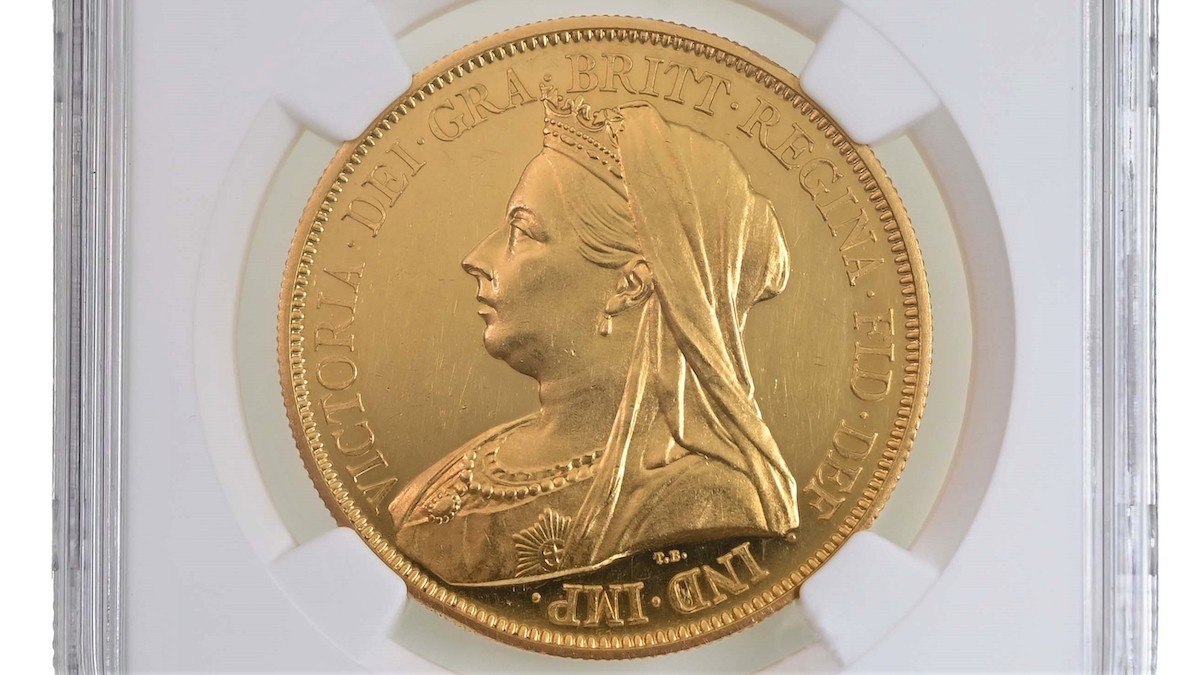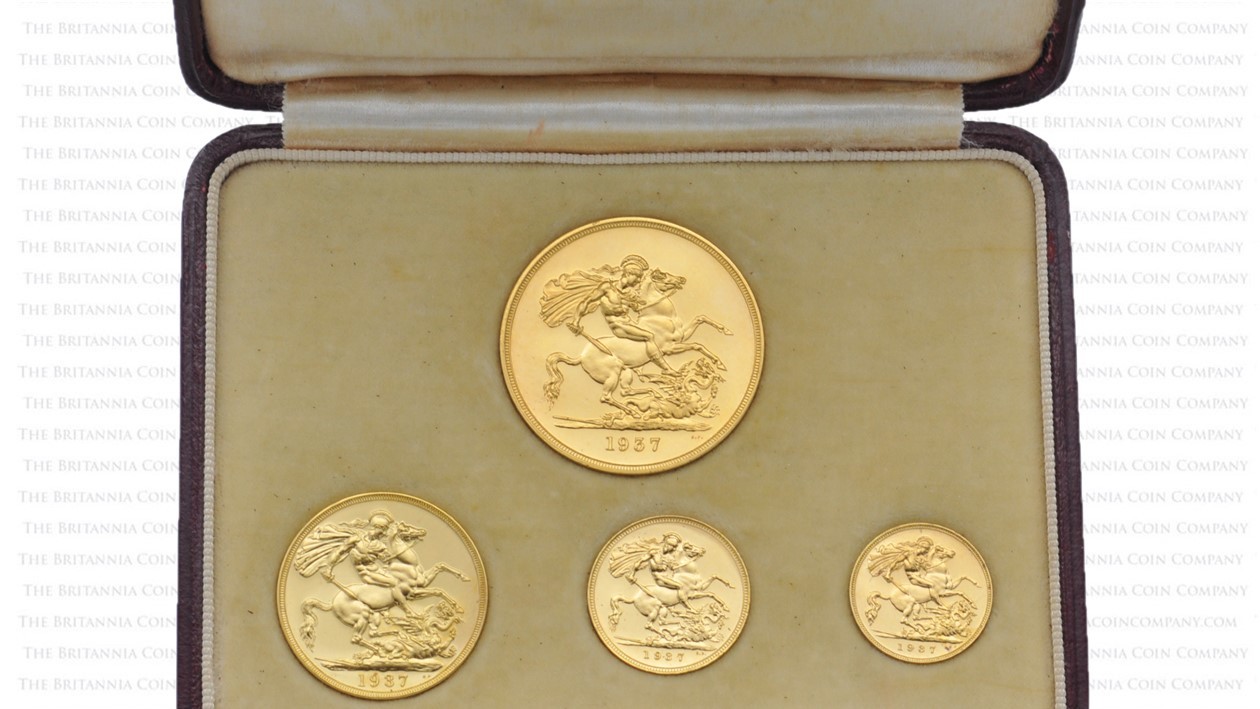
What's the difference between a gold Crown and a Quintuple Sovereign? Both of these large gold coins have a nominal face value of Five Pounds and similar specifications. They've also got a long history that traces back to the largest gold coin to ever circulate in Britain.
But how do you distinguish between gold Five Pounds and Five Sovereign pieces? And what historic Five Pound coins are available? We've got all the details below.
The Gold Five Guinea
First struck in the reign of Charles II, gold Five Guinea coins were also known as Five Pound pieces. That's because a single Guinea was once worth twenty shillings, the equivalent of One Pound sterling so a Five Guinea coin was worth - at least for a while - Five Pounds.
The value of Five Guinea coins fluctuated through the decades so they are usually regarded as a distinct denomination. However, they did have comparable specifications, weighing between 41 and 42 grams. A modern gold Five Pound Crown coin, by contrast, weighs 38.60 grams.

A 1668 Charles II gold Five Guinea coin from the collection of the Cleveland Museum of Art.
As Britain's largest, regularly produced gold coin, Five Guineas were machine minted through Charles' reign, that of his brother, James II and under William and Mary, Anne, George I and George II. After the last Five Guinea piece was minted in 1753 it would be another 67 years before a similarly sized gold coin struck.
The First Gold Five Pounds
British gold coinage was revolutionised in the early nineteenth century with the Great Recoinage. This program, overseen by William Wellesley-Pole, saw the introduction of the modern Sovereign, first struck in 1817. These new gold coins featured a portrait of George III and a now famous design showing a mounted Saint George, slaying a dragon: both the work of Italian artist, Benedetto Pistrucci.
These designs by Pistrucci were also used on the first gold Five Pound coins, struck as pattern pieces in 1820: the last year of George III's reign. Only 25 were produced, entering institutional, museum and private collections after plans for a circulating Five Pound were scrapped with the king’s death.
Five Pound coins were minted twice during the reign of George IV. Between 150 and 225 were struck in 1826. A unique proof appears to have been struck in 1829. The 1826 gold proof Five Pound coins are somewhat larger than their later counterparts, weighing in at 40 grams and measuring 38 millimeters in diameter.

Obverse of a pattern 1826 George IV gold Five Pound, also in the collection of the Cleveland Museum of Art.
Five Pounds of Queen Victoria
Three issues of gold Five Pound coins were made during the reign of Queen Victoria.
The first and probably the most famous were struck in 1839 and featured a unique reverse, created by the Royal Mint's Chief Engraver, William Wyon. His 'Una and the Lion' design is regarded as among the most beautiful to appear on British money. Only 300 to 500 of these Five Pound coins were minted in the artist's lifetime though Una has reached a new audience with the Royal Mint’s Great Engravers series.

William Wyon's Una and the Lion as she appears on a modern Two Ounce gold coin.
The denomination appeared again in the year of Victoria's Golden Jubilee with a new crowned effigy of the monarch paired with the Saint George reverse. The Five Pound coins issued in 1887 were the first to circulate. Supposedly some 54,000 pieces were struck with an additional number offered in proof sets.
The unpopular Jubilee portrait was replaced in 1893 and its replacement - the Veiled or Old Head was celebrated with an issue of 773 commemorative gold proof sets. A Five Pound coin was the largest piece in these collectors sets and is today highly sought-after.

1893 gold proof Five Pound graded PF 62 Cameo.
Coronation Proof Sets
In the early twentieth century, Five Pound coins were struck only in coronation years.
A surprising large number were issued in 1902: the first year of Edward VII's coinage. 8,000 matte proof Five Pound coins were included in 13-coin Royal Mint sets while a further 43,000 were offered in a non-proof uncirculated finish. The Sydney Mint also struck a 1902 gold Five Pound, identified by an 'S' mint mark, though these are very rare.
Smaller mintages marked the coronations of George V (1911: 2,812) and George VI (1937: 5,501). These gold coins were initially only available in proof sets and both featured Pistrucci’s Saint George to the reverse.

A 1937 George VI four coin Sovereign set with the Five Pound piece displayed at the top.
Prototype Five Pound coins were prepared for Edward VIII before his December 1936 abdication. All extant patterns from this cancelled coinage are supremely scarce but the gold £5 piece is the rarest of the lot with only three known. One of these sold for a record-breaking £1.65 million in March 2021 making it the most expensive UK coin to date.
Early Elizabethan Five Pounds
Commemorative specimen sets, issued in the year of Elizabeth II's coronation did not include any gold coins.
A very small number of 1953 gold pattern pieces were struck for continuity, including gold Five Pound coins. These were not available for sale and were instead presented to members of the royal family and national museums.
In 1957, when the production of gold Sovereigns recommenced, Five Pound coins were minted though - again - for completeness, not public release.
It was not until 1980 that somewhat regular production of Elizabeth II gold Five Pounds began. Confusingly, two types of gold Five Pounds have been offered by The Royal Mint in the ensuing decades:
- The Quintuple Sovereign or Five Sovereign piece
- The modern gold Five Pound Crown
These coins have the same nominal face value and are both composed of 39.94 grams of 22 carat gold. There are, however, some differences worth noting.
Modern Quintuple Sovereigns
In 1980 the Royal Mint offered their first modern gold Sovereign proof set, containing a Half Sovereign, full Sovereign, Double Sovereign and a Quintuple Sovereign: exactly five times the weight of an ordinary Sovereign.
The denomination did not appear again until 1989 when it was included in the sought-after Sovereign set issued to mark 500 years since the first Tudor Sovereigns. The 1989 Five Sovereign piece featured a one-year-only obverse and reverse, designed by Bernard Sindall.

The 1989 Quintuple Sovereign was the largest gold coin offered in four coin proof sets issued in this year.
Subsequent Quintuple Sovereigns - struck in every year since - have largely shown Pistrucci's St George on their reverse, the effigy changing as new coinage portraits are introduced. The exceptions to this are proof Five Sovereign coins issued in 2002, 2005, 2012 and 2022 which bear special, one-year-only reverse designs.
Quintuple Sovereigns are available individually in a range of finishes as well as forming part of larger annual Sovereign sets.
Commemorative £5 Crowns
The other type of gold Five Pound coin issued by The Royal Mint are continuations of the British Crown coin.
Before British currency was decimalised, Crowns were worth five shillings. They were retarrifed with a nominal value of 25p in 1971 which was revised again to £5 in 1990. Crowns or Five Pound coins struck since have been offered in cupronickel, silver and gold. They are legal tender but are really intended for collectors and often feature a reverse design inspired by a historic anniversary.

This 2015 Longest Reigning Monarch £5 Crown is one of several modern Crowns that commemorate royal events and milestones.
Gold coins with a face value of Five Pounds also form part of several recent Royal Mint collections including Music Legends, The Queen’s Beasts and the Lunar series.
Gold Five Pound Crowns weigh the same as a Quintuple Sovereign but have a diameter of 38.61 millimeters: the same as historic Crowns minted since the Great Recoinage of 1816. Modern Five Sovereign pieces, by contrast, measure 36.02 millimeters across.
Find Out More
We're proud to source and sell a range of modern and historic Five Pound Crowns and Five Sovereign pieces, both raw, graded and in sets. Some of our current stock is listed below.
Looking to sell a gold Five Pound piece? Contact The Britannia Coin Company today for a valuation.




.jpg)
.jpg)

